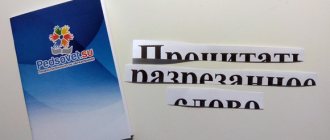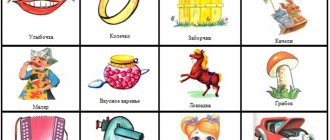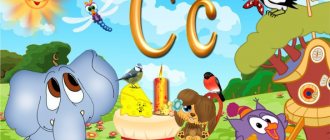Every parent who cares about their harmonious, correct and holistic development thinks about the importance and role of reading in the life of their children. But if in some families it is enough for mothers and fathers to simply send their child to kindergarten or school, shifting, without it sounding too loud, the responsibility onto the shoulders of educators and teachers, then in others caring parents prefer to work with their children on their own.
The information from this course is intended specifically for people of the second category, because those who belong to the first are unlikely to search for relevant information on the Internet. But let's continue.
Despite the great desire to teach your precious child to read as soon as possible, this process should be approached with maximum attention and caution, because there are subtleties and nuances here that you simply cannot turn a blind eye to. The fact is that, contrary to the popular belief that the sooner you start learning the basics of reading with your child, the better, many specialists (neurologists, child psychologists, etc.) are convinced that this can lead to negative consequences in the future. For example, early learning to read with accompanying premature loads on the visual system often becomes the cause of myopia and other vision problems.
Thus, it is very important to know at least the basic features of the formation of a child’s body, when to start teaching children to read and how their readiness for this process is determined, as well as to adhere to the basic relevant rules. These fundamental questions will be discussed in the first lesson.
How a child is formed. general information
Here, as you should understand, we will present only general information, because... it will be quite enough.
So, starting from the early stages of pregnancy and ending at the age of three, the first functional block of the baby’s brain is formed, which is responsible for his bodily, cognitive and emotional perception.
From three to five to eight years, the formation of the second functional block of the brain occurs, which controls the five senses - touch, taste, smell, hearing and vision.
As for conscious mental activity, it develops in a period of approximately seven to fifteen years.
It should be borne in mind that the formation of functional brain blocks is a sequential process. Any attempt by a parent to “skip” any stage negatively affects the natural development of the child, because unnatural “adjustments” are made to it. The insidiousness of the consequences lies in the fact that, quite likely, they will not be felt immediately, but over the years. Subsequently, an already matured child may develop problems, expressed not only in speech disorders, neuroses, motor disturbances, etc., but also in difficulties in relationships with other people.
Based on this, you need to start teaching your child to read at a certain time.
When can you start teaching your child to read?
There are several opinions about when you can start teaching your child to read. Some experts believe that you can start certain work, for example, showing Doman cards (we will talk about them and other methods in the second lesson), when the baby reaches six months of age, while others believe that it is best to start at 3-4 years , and precisely from the ABC book. However, all teachers agree on one thing: no teaching of reading is completely unacceptable and impossible until the child has mastered speech skills. If, around the age of 3-4, the child begins to take an active interest in books, it is not only possible, but also necessary to begin learning to read.
It is also worth noting that if you show restlessness and indifference to printed materials, before learning, you should understand how to arouse the child’s interest in reading. We will touch on this issue in more detail in a separate lesson, but we will still say that in solving this problem, parents will be helped by an incredible selection of books that stand out, in addition to brightness and colorfulness, by the presence of many moving elements and even sound. Thanks to this, reading becomes not just an interesting activity for children, but also an exciting game. At the initial stage, any book serves not so much as a source of knowledge, but as a way to become familiar with the reading process itself.
Continuing the conversation on the topic of a child’s readiness to read, it can be determined by several criteria:
- Firstly, the baby has already formed speech, and he is able to pronounce words and sentences, as well as compose at least small coherent stories
- Secondly, the child does not have speech therapy disorders, and this applies to both incorrect pronunciation and violations of the melody and tempo and rhythm of speech
- Thirdly, the baby is able to navigate normally in space, and does not confuse the concepts of “right”, “left”, “down” and “up” with each other.
- Fourthly, the child has sufficiently developed phonemic hearing, i.e. he can easily recognize sounds in different parts of words
If problems are observed with any of the above, you should begin to eliminate them - spend some time working on the issues causing difficulty, visit a speech therapist, neurologist, etc. If everything is in order (or after the problems have been eliminated), you can move on to learning to read.
Basic principles of games
There is one very sure way to discourage a child from reading - this is to constantly test him: “Tell me, what letter is this?”, “Read what is written here!” Having shown a letter to a child a couple of times, we expect that by the third time he will already name it, or even better, read the word with its participation. If you want to really interest your child in reading, then put off at least for a while trying to examine your child and just read with him!
It is natural that a child just beginning to become familiar with the world of letters cannot read a word. Therefore, when showing words to your child, do not require him to read, but at first read for him yourself! You can also trace the letters with your baby’s finger. After some time, the child will definitely begin to recognize words and phrases and will repeat them after you.
Sometimes a word needs to be read slowly, highlighting each word in it, sometimes it is necessary to name the entire word so that the baby learns to perceive the words as a single whole.
While reading, you can name individual letters (for example, if you don’t like the warehouse approach), but in this case it is advisable to pronounce not the name of the letter (“el”, “ka”), but the sound that corresponds to this letter (“l”, "To").
A few words about proper reading teaching
The presented question worries, perhaps, every parent. And the first answer to it will be the traditional method, which boils down to daily monotonous exercises in reading the primer. But this option is not very effective, because the child almost always becomes bored, he quickly gets tired and tired. Plus, he doesn’t learn to read thoughtfully at all. Of course, the baby will master some skills and knowledge, but calling this a good way of sensory-emotional development, knowledge of the world around us and one’s place in it is a stretch. In order for the process to become exciting and creative, so that it arouses interest in the child, so that the reading skill is mastered effectively, it is necessary to use other methods (we have devoted separate lessons of our course to such methods, and for now we will not focus on them).
Before you start learning to read and use any methods, you must learn the basic rules that you should rely on in your activities. They can be called the basis of this entire process. Although small deviations are allowed, it is still recommended to adhere to all the rules, otherwise the child will master the reading skill less effectively, which should not be allowed under any circumstances.
How to understand that it’s time: signs of psychological readiness
- The child speaks fluently in sentences and understands the meaning of what is said.
- The child distinguishes sounds (what speech therapists call developed phonemic hearing). Simply put, the baby will easily understand by ear where the house and the bow are, and where the tom and the hatch are.
- Your child pronounces all sounds and has no speech therapy problems.
- The child understands directions: left-right, up-down. Let's skip the point that adults often confuse right and left. To learn to read, it is important that the baby can follow the text from left to right and from top to bottom.
Basic rules for teaching a child to read
So, if you intend to help your baby master such an important skill as reading, adhere to the following rules:
1
Don't force
Remember that you cannot force a child to read, and any such strategy is erroneous, incorrect and ineffective. To make your child want to read and begin to show interest in books, just surround him with them. So, you can place books around the house - on shelves, tables and other easily accessible places. In addition, you need to pick up books yourself and read something interesting to your son or daughter. You also need to read for yourself so that the child sees you with a book. Given that children strive to be like their mothers and fathers, your child will most likely ask what you are doing, or pick up a book himself.
2
First sounds, then letters
Many parents make a big mistake by first explaining to their child the pronunciation of letters, and only then – sounds. It is necessary to do the opposite: first of all, it is important to tell what sound a particular letter in a word has, and only then how it is pronounced by itself. Those. initially explain that the letter “er” in the word sounds like “r”, “en” - like “n”, “em” - like “m”, etc. And after that, teach that “er” is “er”, “en” is “en”, “em” is “em”, etc.
3
Learn not letters, but syllables
You need to understand that syllables, and in some cases even whole words, are learned by children much better than many single boring letters. Therefore, letters must be shown in whole words. As auxiliary material, you can use specially printed cards with syllables, with the help of which it is convenient to teach your child to read syllables and form words.
4
Repetition
The frequency of repetition of the material studied with the child determines how well he will remember and assimilate it. However, there is one trick here - many kids do not really like being tested and tested, and therefore repetition as a teaching method should be presented in the form of a game.
5
First simple, then complex
As we said, initially it is most effective to teach a child to pronounce sounds, and only then complicate the process - move on to reading syllables and combining syllables into words. All information should be provided in doses and stages, so that a “porridge” of the acquired knowledge does not arise in the child’s head.
6
Learn simple words
Learning to read should always begin with the simplest words, where letters are repeated, for example, the words “mom”, “woman”, “dad”, “uncle”, etc. After this, it is allowed to move on to teaching words where a letter is added to a syllable, for example, “bass”, “cat”, “house”, “poppy”, “varnish”, etc. And having already mastered such material, you can begin to study elementary sentences, such as “Mama washed Mila,” “Kolya kolit kolja,” etc. As for the letters “й”, “ь” and “ъ”, it is better to leave them for last.
7
Learn anytime, anywhere
It doesn’t matter what you and your baby are doing at the moment: walking, shopping, standing at a bus stop or having a snack in a cafe - you can read anywhere and anytime. Almost everywhere there are signs, advertising posters, plates with the names of shops, streets, bus stops, etc. Use this to your advantage and your child's, and let him read whatever you point him to.
8
Play
Teaching a child to read, as well as any other skill, should take place in a playful way. Come up with your own games where you need to know sounds, letters and syllables. For example, you can ask your child to look for specific letters in words and pronounce them. You can also buy letters on magnets for home and write words on a special board or refrigerator. And another game will help develop attentiveness - take letters on magnets or cubes, make a series of letters where all but one are consonants, and let your baby find the vowel letter.
9
Arouse interest
In order for your child to master reading better and easier, you need to interest him in it. And for this it is very good to show that reading is necessary for a full life among other people. Therefore, clearly demonstrate to your child the importance of this skill - show him letters, postcards, notes, signs, write notes for him to read. Over time, the child himself realizes that learning to read is simply necessary.
10
Read aloud
Reading aloud, and even for a while, is considered a very effective way to teach a child to read quickly. But it should be used, of course, when the baby has already mastered some skills. Based on what your child has already learned, compose your tasks and give them to him to complete, timing, for example, a minute. By the way, the so-called “Reader’s Diary” will be very helpful here, where you will record your baby’s progress. And so that he completes tasks with enthusiasm, after every hundred words he reads, give him some pleasant little thing.
11
Read with bookmark
Reading with a bookmark is another rule for improving the development of reading skills. You need to use the bookmark here as usual, with the only difference that it should cover not the bottom line, but the read words. This way you will help your baby not to get confused in a large number of words and focus his attention on a new word.
12
Regularity of classes
We have already talked about repetition, so we’ll just add that you need to read regularly and systematically. In other words, you need to pay attention to mastering the skill of reading every day, even if it only takes 5-10 minutes. But what is even more important is not to abandon classes, even when it begins to seem that the child is already reading well.
And at the end of the first lesson, we would like to supplement the above rules with a few more recommendations that will help you teach your child to read faster and better.
Benefits
“Quick learning to read” Nefedova E., Uzorova O.
Link to the book : https://www.litres.ru Cost : electronic version - 49 rubles, paper version - from 299 rubles.
The manual is intended for children of preschool and primary school age during the period of learning to read. A large number of exercises are offered for reading syllables, words, as well as short texts. For convenience, all words are divided into syllables. In addition, the manual contains tasks for work on phonetic, lexical and structural analysis.
“Encyclopedia of methods for teaching reading. Letters, syllables, cubes” by L. Kirillova
Link to the book : https://www.litres.ru Cost : digital version - from 139 rubles, paper version - from 216 rubles.
The book contains descriptions of various approaches and methods of teaching reading: from classical (Leo Tolstoy's alphabet and primers) to the most modern, fashionable and non-traditional (Glenn Doman's method, Tyulenev's system, computer programs for teaching reading, etc.). The book also provides extensive recommendations and exercises for practical lessons in teaching reading.
“How to teach a child to read from 3 years old” S. Fedin, D. Kuzina
Link to the book : https://www.litres.ru Cost : digital version - from 249 rubles, paper version - from 488 rubles.
The book includes seven sequential steps in teaching preschoolers to read with detailed recommendations for parents on how to properly structure the learning process and how to interest their child in reading and writing. And to consolidate the acquired skills, at the end of the book you will find a reader with funny stories.
“I want to read. For children 5-6 years old" V. A. Egupova
Link to the book : https://www.litres.ru Cost : digital version - from 99 rubles, paper version - from 111 rubles.
The purpose of the manual is to teach the child to read syllables and write words and sentences in block letters. At the same time, the child learns to distinguish between vowels and consonants, sounds and letters, hard and soft, voiced and voiceless consonants; determine the stressed vowel and the number of syllables in a word. The manual uses poems, riddles, and tongue twisters.
A few additional recommendations
Your child will learn to read more successfully if you follow this list of recommendations:
- Be sure to get a primer or alphabet book. In the future, this literature will always evoke associations in the child with pleasant learning. It is best if the books are supplemented with drawings
- If you are learning letters, then start with vowels, because you can sing them using your favorite melodies, and this is useful, fun, and interesting. It is very good if classes are accompanied by modeling from plasticine or coloring pictures. This will teach your baby to identify letters and understand them.
- You need to study consonants only after vowels. And don’t forget that you first need to explain to your child how a letter in a word is pronounced, and only then how it sounds on its own.
- To increase the effectiveness of learning, it is useful to compose fairy tales about letters so that getting to know them is more interesting for the child. For example, once upon a time there was a cheerful letter “U”. And one day she climbed up a hill and rolled down it, cheerfully shouting “Woohoo!” Using analogy, make up short stories for each letter
- Don't neglect creative materials during your learning process. Remember that a child learns about the world through sensory perception, which means that he definitely needs to try and touch everything. Cutting out letters from cardboard, sculpting letters from plasticine, baking cookies in the shape of letters, etc. may be suitable. An experience like this will be forever etched in your child's memory.
- The most effective are short sessions of 10-15 minutes, several (3 to 5) times a day. Stick to this system, and your baby will not only not get tired, but will also look forward to each lesson.
- And finally, the most important rule in any interaction with a child is kindness and patience with the baby. Never allow yourself to lose your composure, raise your voice, or even insult the little man. Otherwise, all the activities will be of no use, and the child’s attitude towards you may not be the best.
Approach teaching your child to read with love and intelligence, and the first results will not take long to arrive. And in the next lesson we will talk about the most popular methods of teaching children to read today, and also briefly talk about what we were based on when creating the presented course.
Lesson 1. The most popular methods of teaching children to read
Almost each of us today can remember the famous blue primer with which we learned to read. But time passes, and the presented tool loses its relevance, giving way to special methods of teaching children to read. Today you can find many such methods, but we will tell you about the most popular ones, and also point out their main advantages and disadvantages, if any. Of course, we will say a few words about the primer, and also introduce the benefits of practical methods for teaching children to read, collected in this course by the 4Brain team. But, as is our custom, let’s talk about everything in order.
To begin with, it would not be amiss to note once again that it is recommended to teach children to read no earlier than 4-5 years old, but cases are not excluded when children begin to master this skill earlier (we talked about indicators of children’s readiness for reading in the first lesson). The author's methods that we will talk about are designed for early, i.e. primary education of children.
Lesson 2. The most important points when teaching children to read. An easy way to teach your child to read
In the two previous lessons, we looked at the basics of teaching children to read and got acquainted with the most popular methods on this topic. But the theoretical aspects do not end there, because teaching a child to read is not an easy task. Naturally, we will not overwhelm you with theory, otherwise the course will simply be of no use, but we will still allow ourselves to touch on a few more issues of a similar nature.
If you want to make sure that your child’s reading education is as effective as possible, you should pay attention to a number of certain nuances, which we will discuss below. We also note that the recommendations we offer have been tested in practice by many parents and have shown their effectiveness on many generations of children. Despite this, they are extremely simple, and following them will not be difficult for you. Plus, this information will allow you to avoid the most common mistakes. This means that your baby will very soon be able to distinguish between letters, syllables and words, remember them and pronounce them correctly.
Lesson 3. Preparing for reading for little ones. Age characteristics. First books. Methods and recommendations
Remember, just recently you were thinking about how to help your baby solve his first “baby” difficulties - mastering a rattle, teaching him to eat, going to the potty. But time flies unnoticed, and now the time has come for the baby to learn the first skills that will be useful to him in adulthood. And one of them is reading. Preparation for the process of learning to read is very important because... Only with a competent integrated approach will success in this difficult but very interesting matter be guaranteed.
To begin with, let's once again touch upon age-related characteristics, namely: consider what special happens in the period from 3 to 7 years with a child, because both the methods that need to be used for learning and the subtleties of preparation depend on this.
Lesson 4. Learning the alphabet
One of the foundations of reading at all times was knowledge of the alphabet. As one might expect, there are many methods for studying the variety of letters in the Russian language, but not all are effective. In addition, when teaching a child, it is always necessary to focus on psychological and physiological characteristics. The age aspect is of particular importance in the issue of mastering the alphabet.
We have already mentioned that the characteristics of babies in 99% of cases are such that it is quite difficult for them to concentrate. For this reason, purposefully studying the alphabet at the age of 1-2 years does not make any sense (this is precisely the kind of study that is meant to be useful in the future, but, of course, it is possible to prepare for reading), and teachers advise starting this from the age of three. Although you should always and everywhere rely on the individual characteristics of a particular child, and not try to find any age limits. Next we will talk about learning the alphabet by children of different ages.
Lesson 5. Reading by syllables
After the child has mastered the alphabet, and you are sure that from now on information about the letters of the Russian language is firmly entrenched in his head, it’s time to move on to studying syllables. This lesson is dedicated specifically to this topic.
We bring to your attention practical recommendations that will help you teach your baby to read syllables, as well as several home lessons aimed at improving reading skills and abilities. Let's start with recommendations.
Lesson 6. Reading whole words
After completing the lessons, the child can confidently read words, but they sound something like this: “ko-te-nok”, “so-ba-ka”, “ig-rush-ka”, “ki-no”, etc. In other words, the baby reads words, but reads them syllable by syllable. This is quite normal, but you definitely need to work on it, because... Only when the child reads words and sentences entirely and without hesitation can we say that he has really learned to read. In addition, at the same time as learning to read whole words, children must learn to understand the meaning of what they read. We will talk about these topics in this lesson.
But first, let's understand a few very important points - when a child masters reading whole words, it is necessary:
Lesson 7. Quick reading
The ability to read is one of the most important and necessary skills for a person in life. And this is most clearly expressed when the child begins to go to school. The speed and quality of information perception, as well as the success of the entire learning process in general, depends on the ability to read. If a child can read with difficulty, he will study, write down and assimilate the material very slowly, and this in turn will affect his academic performance.
For these and many other similar reasons, every parent who cares about their child and his success in life should not only help him learn to read, but do it as effectively and competently as possible. To put it somewhat differently, he is obliged to teach the child to read correctly, meaningfully and quickly. And in our lesson today we will present a number of techniques and exercises that will help you achieve this result.
Lesson 8. How to make a child fall in love with reading
Enough has already been said about the meaning of reading and the boundaries it opens. Let us just remind you that people who love to read have a much greater chance of success in life. And according to some psychological research, well-read children perform better in school, and their likelihood of receiving higher education increases markedly compared to children who do not like to read.
But how can you make sure that your child both knows how to read and loves this activity? How can you make sure that instead of spending countless hours on social networks or playing on a tablet, he picks up a book and spends time with it?
Lesson 9. Teaching children to read in foreign languages
Teaching a child to read Russian is one thing. This is naturally necessary; Without this, as they say, there is nowhere. But nowadays there is increasingly a need for a person to also know some foreign language, and, of course, this presupposes the ability to read in this language.
In the final lesson, we will look at the basics of teaching children to read in foreign languages, and as an example, as you might guess, we use English. Firstly, it is an international language, i.e. it can be useful to any person in life, and secondly, its relevance is due to the widespread use of computer technology. This is precisely why, by the way, today it is increasingly being taught in schools from the first grade.
And before moving on to the main part of the course, we suggest you think a little about why being able to read and teaching your children to read is so important.
“Running” from one letter to another
(from “The ABC for Kids” by O. Zhukova)
This is a visual exercise that will help a child learn to pronounce two letters together.
Before us is a path from one letter to another. To overcome it, you need to pull the first letter until the finger we move along the path reaches the second letter. The main thing we are working on in this exercise is so that there is no pause between the first and second sound. To make it more interesting to practice, replace your finger with a figurine of any animal/person - let it run along the path and connect two letters.











